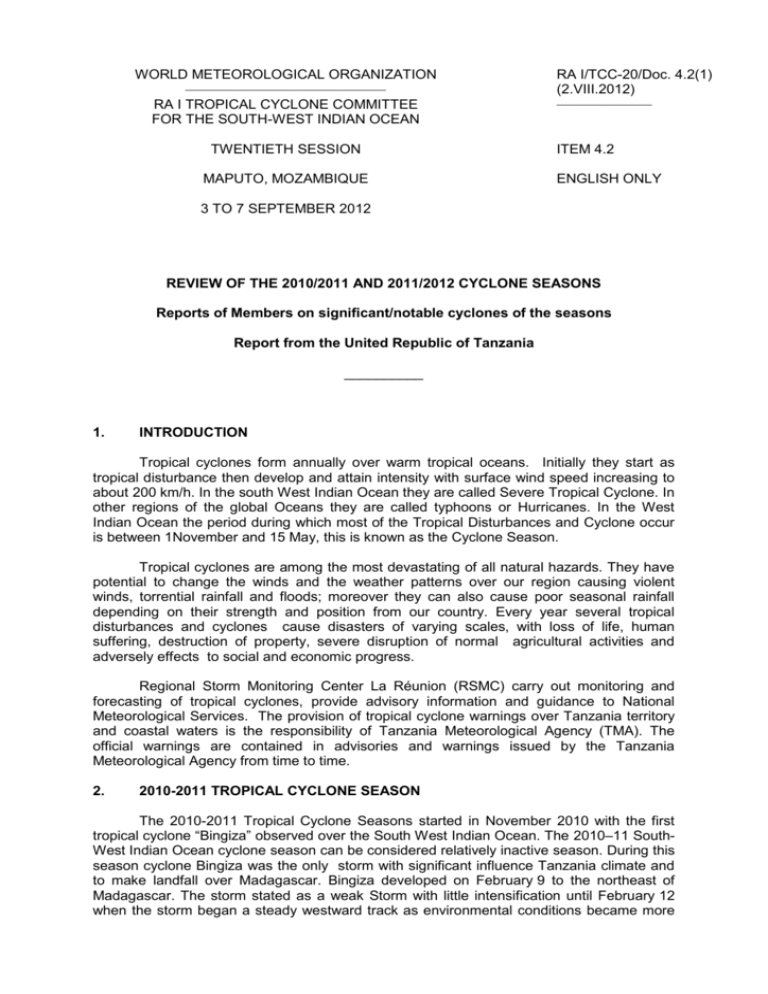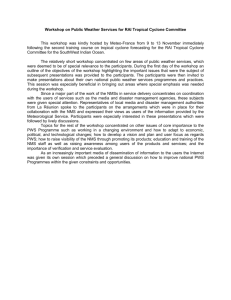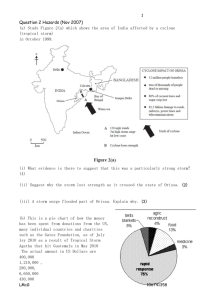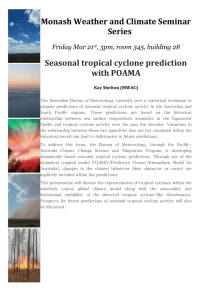4 - WMO
advertisement

WORLD METEOROLOGICAL ORGANIZATION ________________________________________ RA I TROPICAL CYCLONE COMMITTEE FOR THE SOUTH-WEST INDIAN OCEAN TWENTIETH SESSION MAPUTO, MOZAMBIQUE RA I/TCC-20/Doc. 4.2(1) (2.VIII.2012) ___________________ ITEM 4.2 ENGLISH ONLY 3 TO 7 SEPTEMBER 2012 REVIEW OF THE 2010/2011 AND 2011/2012 CYCLONE SEASONS Reports of Members on significant/notable cyclones of the seasons Report from the United Republic of Tanzania __________ 1. INTRODUCTION Tropical cyclones form annually over warm tropical oceans. Initially they start as tropical disturbance then develop and attain intensity with surface wind speed increasing to about 200 km/h. In the south West Indian Ocean they are called Severe Tropical Cyclone. In other regions of the global Oceans they are called typhoons or Hurricanes. In the West Indian Ocean the period during which most of the Tropical Disturbances and Cyclone occur is between 1November and 15 May, this is known as the Cyclone Season. Tropical cyclones are among the most devastating of all natural hazards. They have potential to change the winds and the weather patterns over our region causing violent winds, torrential rainfall and floods; moreover they can also cause poor seasonal rainfall depending on their strength and position from our country. Every year several tropical disturbances and cyclones cause disasters of varying scales, with loss of life, human suffering, destruction of property, severe disruption of normal agricultural activities and adversely effects to social and economic progress. Regional Storm Monitoring Center La Réunion (RSMC) carry out monitoring and forecasting of tropical cyclones, provide advisory information and guidance to National Meteorological Services. The provision of tropical cyclone warnings over Tanzania territory and coastal waters is the responsibility of Tanzania Meteorological Agency (TMA). The official warnings are contained in advisories and warnings issued by the Tanzania Meteorological Agency from time to time. 2. 2010-2011 TROPICAL CYCLONE SEASON The 2010-2011 Tropical Cyclone Seasons started in November 2010 with the first tropical cyclone “Bingiza” observed over the South West Indian Ocean. The 2010–11 SouthWest Indian Ocean cyclone season can be considered relatively inactive season. During this season cyclone Bingiza was the only storm with significant influence Tanzania climate and to make landfall over Madagascar. Bingiza developed on February 9 to the northeast of Madagascar. The storm stated as a weak Storm with little intensification until February 12 when the storm began a steady westward track as environmental conditions became more RA I/TCC-20/Doc. 4.2(1), p. 2 favorable. Within a 24–hour period, Bingiza developed from a moderate tropical storm into an intense tropical cyclone with a well-defined eye. The cyclone moved ashore in northeastern Madagascar on February 14 and quickly weakened as it crossed the country. It emerged into the Mozambique Channel as a weak tropical disturbance. Cyclone Bingiza attained tropical storm status before making its final landfall on February 18. Development of Bingiza and its movement brought much relief over many parts of central and northern Tanzania where dry conditions had been experienced. During the life span of Bingiza much of the wet conditions in the country were linked to enhanced low level wind convergence and moisture from the Indian Ocean and Congo rain-forest. Strong winds were also experienced though no disaster was observed. The season had very few tropical disturbances and cyclones that influenced the climate of Tanzania due to their relative far position and strength. Moreover, most of the storms tracked south westwards along the far eastern coast of Madagascar rather than passing through the Mozambique Channel. The tropical Cyclones were closely monitored based on the reports and bulletins from the Regional Storm Monitoring Center La Réunion (RSMC). 3. 2011-2012 TROPICAL CYCLONE SEASON This season can be considered inactive tropical cyclone season. There were no tropical disturbances in the region. 4. SUMMARY During the Tropical Cyclone Season 2010-2011, only Cyclone Bingiza could be linked to enhanced wet conditions and windy over the country. The 2011-2012 was inactive season. Information from Regional Storm Monitoring Center La Réunion (RSMC) was very useful in the country’s operational weather monitoring, forecasting and early warning. _____






